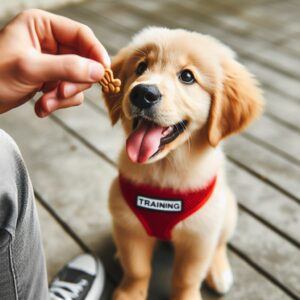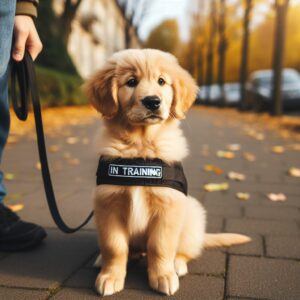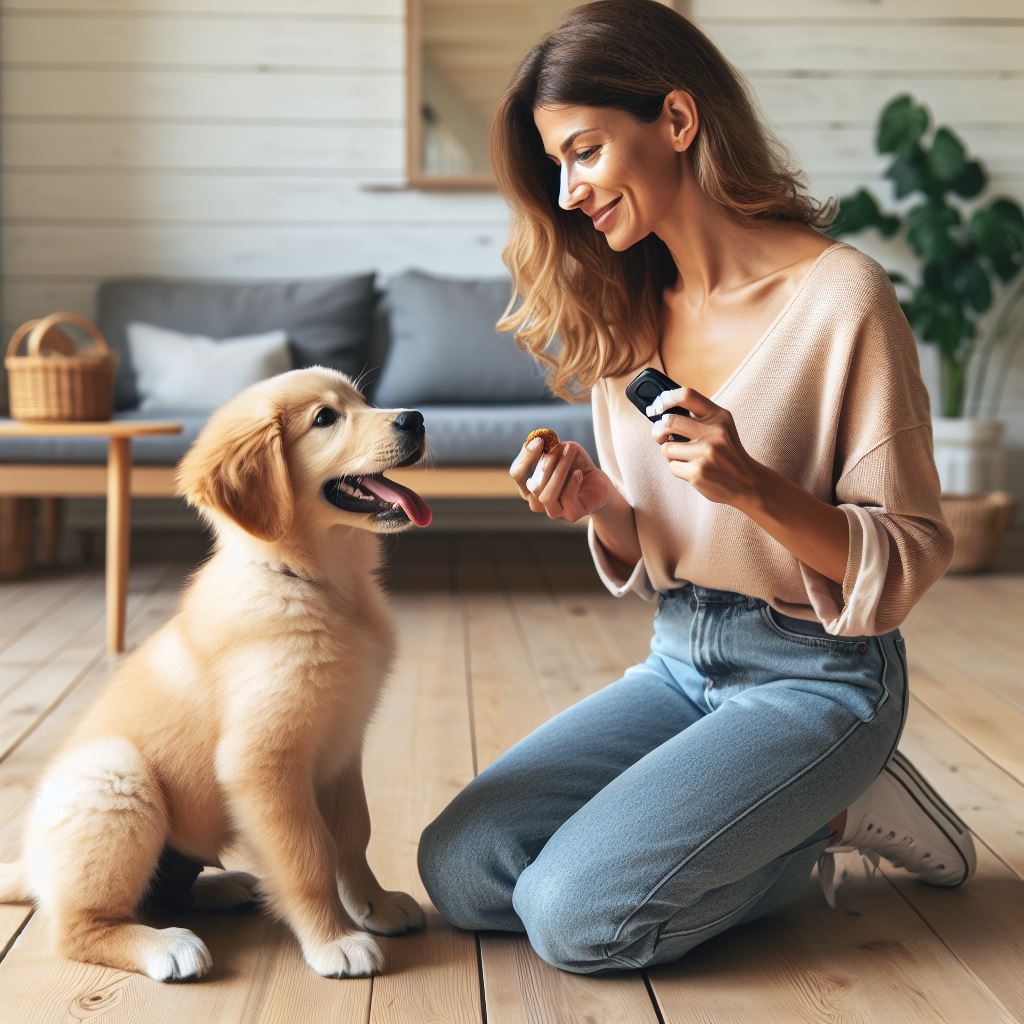You’re probably here because you’ve heard of positive reinforcement training and want to understand more about it. Positive reinforcement is a training method that encourages good behavior by rewarding it, a concept rooted in behavioral psychology. Think of it as your pet’s own ‘like’ button; when they do something that earns a ‘like’, they’re rewarded, making it more likely they’ll do it again.
 This isn’t just about giving treats to pets; it’s about creating a bond based on trust and mutual respect. Unlike punishment-based methods, which can cause fear and aggression, positive reinforcement strengthens your bond with your pet and boosts their confidence. Ultimately, it’s about communication. You’re teaching your pet what behaviors are desirable in a way that they can understand and appreciate.
This isn’t just about giving treats to pets; it’s about creating a bond based on trust and mutual respect. Unlike punishment-based methods, which can cause fear and aggression, positive reinforcement strengthens your bond with your pet and boosts their confidence. Ultimately, it’s about communication. You’re teaching your pet what behaviors are desirable in a way that they can understand and appreciate.
So, what does this mean for pet owners? You can look forward to training sessions that are more enjoyable and stress-free for both you and your furry companion. Plus, positive reinforcement isn’t limited to dogs; it’s effective across a broad range of animals, making it a versatile approach to training.
Now, I’m sure you’re eager to learn how to practically apply these principles. In the next section, we’re going to dive into the foundational principles of positive reinforcement training. From timing to motivation, you’ll get a deeper look at what makes this method tick and how to set the stage for successful training sessions.
Foundational Principles of Positive Reinforcement Training
I’m going to walk you through the core principles that make positive reinforcement training so effective. If you want to see real improvements in your pet’s behavior, these fundamentals are your toolkit for success.
The timing of rewards is not just important; it’s everything. Deliver a treat, praise, or a click from a clicker just as your pet performs the desired action. This crystal-clear communication helps them connect the behavior with the reward.
Next up, let’s talk about motivators. Choose something that resonates with your pet. This could be food, toys, playtime, or even verbal praise. However, it’s crucial to rotate these rewards to prevent boredom and maintain high levels of motivation.
You’re going to find out that consistency and repetition stand as the twin pillars of positive reinforcement. Repeat exercises and maintain the same commands and rewards system. It’ll help your pet understand what’s expected with fewer mixed signals.
What about when the trick or command gets too easy? Gradually increase the challenge. Introducing new commands or adding distractions can help your pet adapt and learn to generalize the behaviors. Small, incremental steps ensure that learning is a journey, not a hurdle.
Implementing Positive Reinforcement in Training Sessions
If you want to get started with positive reinforcement training, you’re going to need a plan. This isn’t just about doling out treats; it’s about strategic and informed actions that will set your pet up for success. I’m here to help you understand how to effectively implement these techniques during your training sessions.
First, it’s crucial to set realistic goals and expectations for your pet. Every animal has its own pace of learning, so be patient and celebrate small victories along the way. This keeps your pet motivated and the training sessions fun and rewarding for both of you.
Next up, creating a conducive learning environment is key. Choose a quiet space with minimal distractions. This allows your pet to focus on the task at hand and can significantly enhance the learning process.
When you encounter unwanted behavior during the training, it’s important to not resort to punishment. Instead, redirect your pet’s attention to a behavior you want and reward that. The goal is to teach your pet what to do, rather than what not to do.
Now, let’s talk about tracking progress. It’s going to be incredibly helpful to make notes after each training session. Note what worked, what didn’t, and any changes you notice in your pet’s behavior. This helps you tailor future sessions and keep a positive trend going.
Remember, you can always adjust your approach down the road. Training isn’t set in stone, and flexibility can lead to better outcomes. Keep your methods adaptable, and don’t worry too much about perfection on the first try.
Real-world Applications and Success Stories
I’m going to take you through some inspiring success stories that showcase the effectiveness of positive reinforcement training. Each tale reinforces the idea that consistent, reward-based training not only transforms behavior but also fosters a deeper bond between humans and animals.
Let’s start with a look at case studies from pet owners. You’re going to find out about dogs that went from unruly to obedient, cats that learned impressive tricks, and even birds that mastered complex tasks. These stories aren’t just about the behavioral changes; they’re about the increased trust and communication between the pet and its owner.
unruly to obedient, cats that learned impressive tricks, and even birds that mastered complex tasks. These stories aren’t just about the behavioral changes; they’re about the increased trust and communication between the pet and its owner.
I also have something pretty exciting to share about the use of positive reinforcement outside domestic settings. Consider the challenges faced by zookeepers and conservationists: they have successfully applied these methods to help endangered species adjust to new environments and participate in their own healthcare. This isn’t just good animal management; it’s a crucial part of protecting biodiversity.
Lastly, I want to give voice to professional trainers. They’ve shared how positive reinforcement isn’t a quick fix—it’s a long-term commitment to the well-being of the animals they work with. Over time, they have seen reticent, fearful animals grow into confident individuals that are eager to engage and learn.
In my opinion, these real-life applications validate the considerable potential of positive reinforcement training. Choose something that resonates with you from these methods to create a positive change that extends beyond the training sessions. Always keep in mind: your first attempt doesn’t need to be your last, and don’t focus too much on perfection. Instead, celebrate every small victory on your journey to a happier, more harmonious relationship with your animal companions.


Hello. You’d be surprised at how trainable dogs actually are. Especially when it comes to positive reinforcement. I think especially with treats. Dogs really respond very well to those. And they are fast learners and they enjoy learning new things. Plus they want to make you happy. I’m just wondering how much time you’d recommend per day teaching your dog tricks? And what treats work the best? Thanks a lot
Hello!
Thank you for your insightful comment! You’re absolutely right—dogs are incredibly trainable, especially when positive reinforcement and treats are involved. Their eagerness to learn and please their owners makes training a rewarding experience for both the dog and the owner.
Regarding your question, consistency and short, frequent training sessions are key. I recommend spending about 10-15 minutes per session, two to three times a day. This keeps the training fun and engaging for your dog without overwhelming them. Remember to end each session on a positive note to keep your dog excited for the next one.
As for treats, it varies depending on the dog, but high-value treats like small pieces of chicken, cheese, or commercial dog treats designed for training usually work best. The treats should be small and easy to eat quickly so that they don’t interrupt the training flow.
I hope this helps! Happy training, and enjoy the wonderful bond that comes with teaching your dog new tricks!
Best regards,
Tim
Well done. This is clear and informative. I currently don’t have a dog because my beloved Jaspar, who had been with me for 18 years, recently died. Now I’m thinking about getting a pup and training it properly, as Jaspar was a bit unruly at times because I didn’t have him as a puppy. So, I’d love your advice about which breed is the most biddable and accessible to break in. Do you recommend pedigrees? In which case, I will lash out and buy a dog. As I’m getting on, this will probably be my last canine companion, so please don’t recommend a huge breed or a tiny yapping healer to get under my feet and trip me up constantly.
I’m sorry to hear about your loss. It’s wonderful that you’re considering welcoming a new companion into your life. Based on your needs and preferences, here are some dog breeds that are known for their trainability, moderate size, and suitability for older adults:
### 1. **Labrador Retriever**
– **Size**: Medium (55-80 pounds)
– **Temperament**: Friendly, outgoing, and highly trainable
– **Energy Level**: Moderate to high (requires regular exercise but generally calm indoors)
– **Grooming**: Moderate (regular brushing needed)
### 2. **Cavalier King Charles Spaniel**
– **Size**: Small to medium (13-18 pounds)
– **Temperament**: Affectionate, gentle, and good with families
– **Energy Level**: Moderate
– **Grooming**: Moderate (regular brushing and occasional professional grooming)
### 3. **Poodle (Miniature or Standard)**
– **Size**: Miniature (10-15 inches at the shoulder), Standard (15+ inches at the shoulder)
– **Temperament**: Intelligent, trainable, and hypoallergenic
– **Energy Level**: Moderate to high (needs mental stimulation)
– **Grooming**: High (requires regular grooming and clipping)
### 4. **Golden Retriever**
– **Size**: Medium to large (55-75 pounds)
– **Temperament**: Friendly, reliable, and great with families
– **Energy Level**: Moderate to high (enjoys regular exercise)
– **Grooming**: Moderate (regular brushing needed)
### 5. **Shih Tzu**
– **Size**: Small (9-16 pounds)
– **Temperament**: Affectionate, happy, and adaptable
– **Energy Level**: Low to moderate
– **Grooming**: High (requires regular grooming)
### 6. **Bichon Frise**
– **Size**: Small (12-18 pounds)
– **Temperament**: Playful, curious, and hypoallergenic
– **Energy Level**: Moderate
– **Grooming**: High (requires regular grooming)
### 7. **Cocker Spaniel**
– **Size**: Medium (20-30 pounds)
– **Temperament**: Friendly, gentle, and good with families
– **Energy Level**: Moderate
– **Grooming**: High (requires regular grooming and trimming)
### Recommendations
– **Trainability**: Labrador Retrievers and Poodles are among the easiest breeds to train, making them ideal for owners who want a biddable dog.
– **Size**: Given that you prefer a moderate size, breeds like the Cavalier King Charles Spaniel, Miniature Poodle, and Cocker Spaniel fit well.
– **Grooming**: If you prefer lower grooming needs, Labrador Retrievers and Golden Retrievers are better options.
**Pedigrees**: Pedigree dogs can be beneficial if you’re looking for specific traits and predictability in behavior and health. However, it’s essential to choose a reputable breeder who prioritizes health and temperament over appearance.
### Final Suggestion
Considering your desire for a manageable size, trainability, and a loving companion, a **Cavalier King Charles Spaniel** or a **Miniature Poodle** might be the perfect choice. Both breeds are affectionate, easy to train, and adapt well to various living situations.
Whatever breed you choose, ensure that you spend time researching and possibly meeting the breed to ensure it aligns with your lifestyle and preferences. Good luck with your new furry friend!